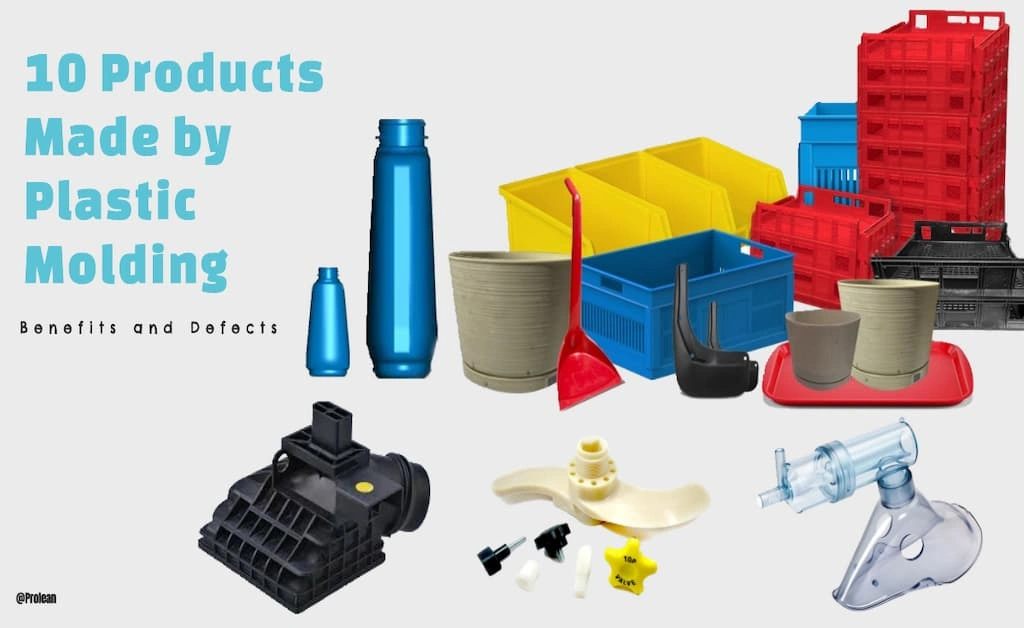
The use of plastics is extensive in today’s world, where most of them are manufactured with molding processes —the approach of shaping molten plastics by solidifying them in a cavity outlining the geometry of the desired item.
Moreover, products made of plastic molding are everywhere, from simple storage boxes in our kitchen to complex engineering items like air duct systems, EV components, and Medical device parts.
If you are looking for plastic molding products or trying to outsource from a secondary manufacturer, this article is for you. This will examine the top 10 product examples, raw material options, what benefits this technology offers, and what are the possible defects in molded items.
Let’s get started.
Is Plastic Molding the Same as Injection Molding?
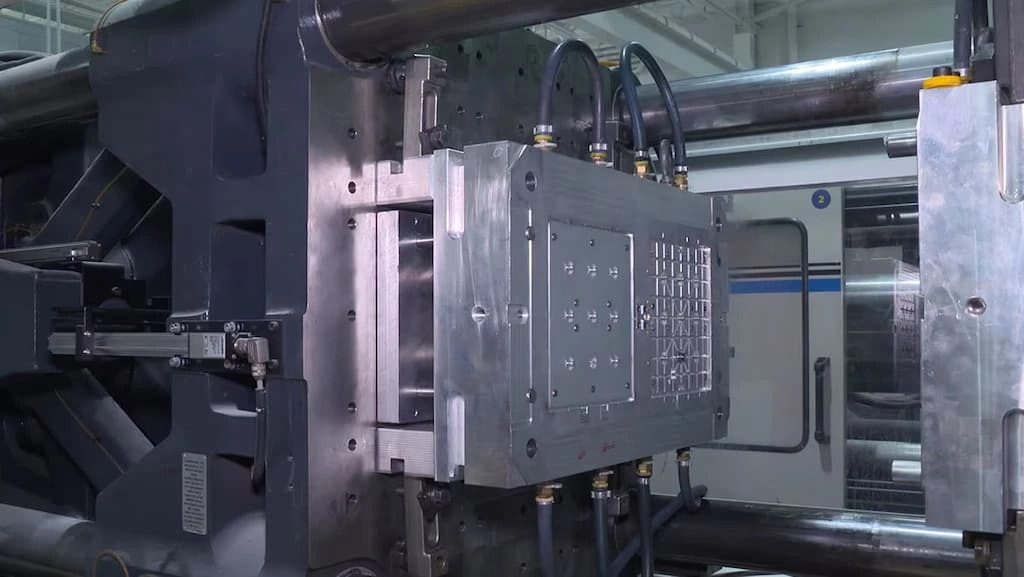
Plastic injection molding
Plastic molding is a broader term that includes several types of methods, such as blow molding, injection molding, rotational molding, compression molding, etc. Meanwhile, injection molding is one of its methods, and it is known for precision and high-volume runs.
“You can understand injection molding more as a sub-type of plastic molding, which involves injecting the liquid thermoplastics or feedstock containing binders at high pressure 500 to 1,000 bar, or even higher.”
The current trends also suggest the dominance of injection molding technology in the plastic parts manufacturing market, with an estimated size of $309 billion, covering almost 70% of the overall plastic parts market.
Try Prolean Now!
10 Products Made by Plastic Molding
1. Plastic Bottles
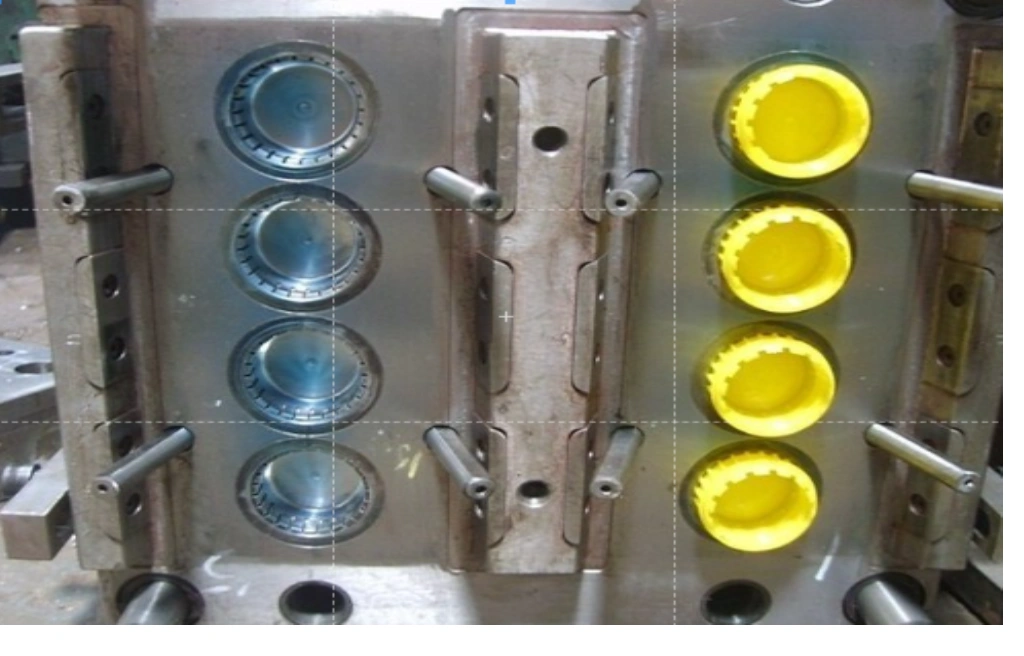 Bottle cap molding
Bottle cap molding
Molding not only makes water drinking bottles but also small to large-sized plastic bottles for packaging other liquids like juice products, cold drinks, and cosmetics. Subsequently, mass production with consistent quality significantly reduces production costs. For example, most hair shampoo companies use blow plastic molding to make their packaging bottles, whereas their sealing caps are made with injection molding.
Materials like Acrylonitrile Butadiene Styrene(ABS), polyethylene terephthalate (PET), and Polyethylene(PE) are common for plastic bottle molding.
2. Toys and Custom LEGOS
Most of the children’s toys are injection molded with eye-catching aesthetics and colors. The capability of making small and complex shapes makes it ideal for toy products like dolls, model cars, other vehicles, action figures, etc. Furthermore, You can also make injection molding LEGO toys and bricks.
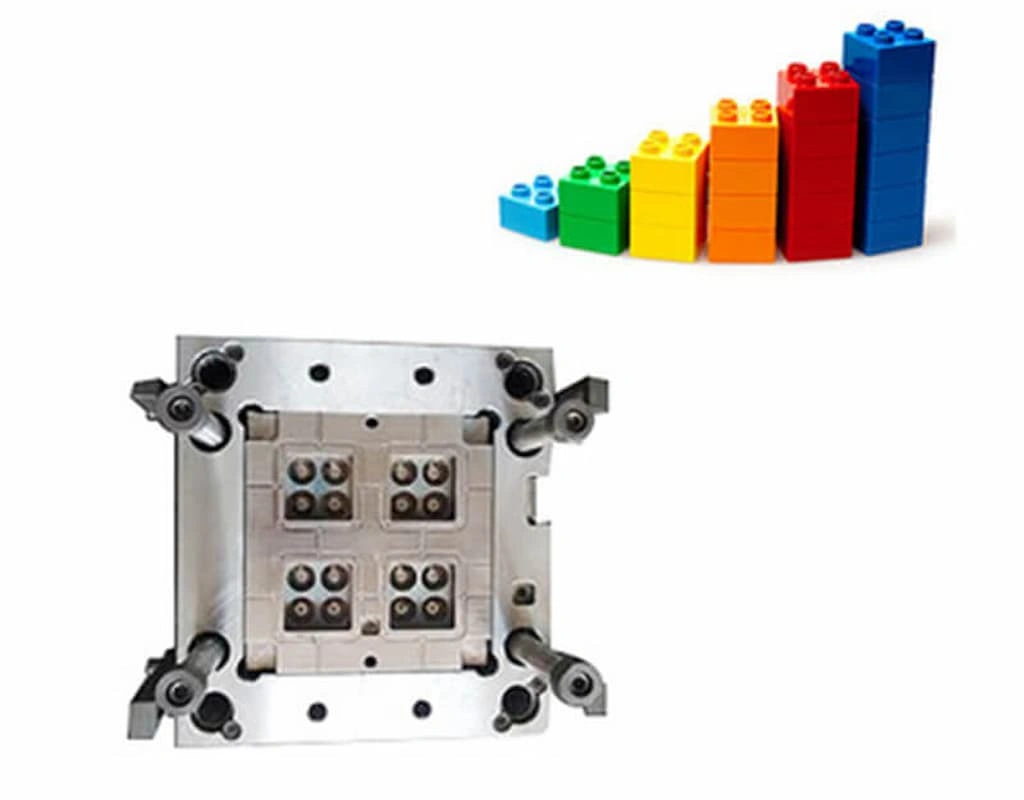
Lego bricks molding
Subsequently, plastics to mold toys are ABS, HDPE, LDPE, Polycarbonate, Nylon, and Polyvinyl Chloride (PVC).
3. Smartphone and Electronics Housing
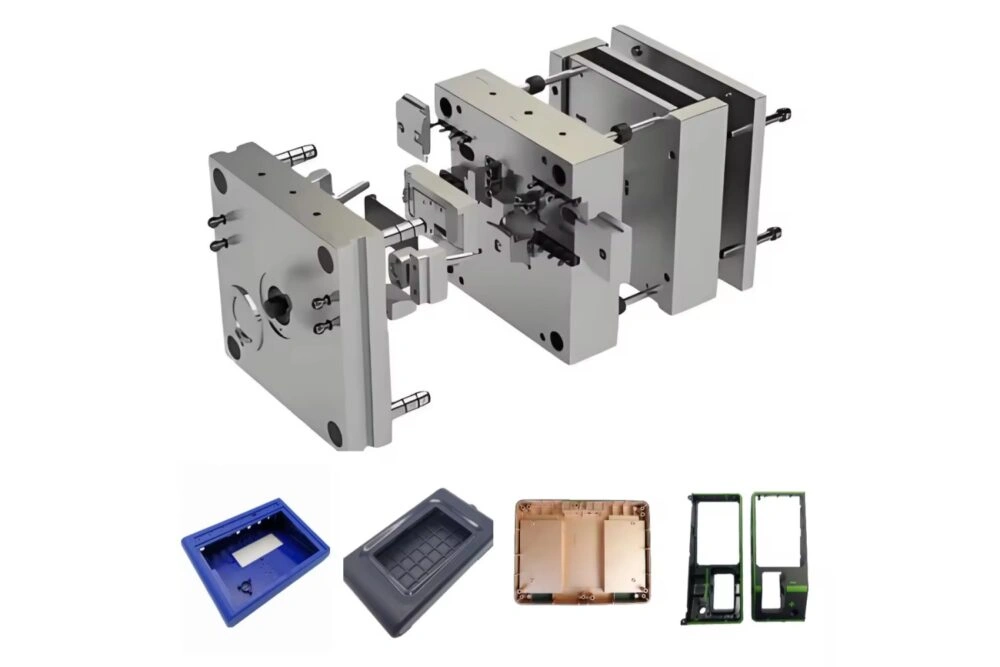
Molded plastic casings
Casing for smartphones and electronic items are other prominent examples of products made by injection molding. Many companies produce lightweight and durable housing for remote controls, routers, thermostats, amplifiers, game controllers, desktops, laptops, and tablets. You can make smooth finishes for these enclosures with custom color designs.
Plastics with high impact strength and toughness, like PC/ABS blend, TPU, and Nylon, are favorable for electronic housings.
4. Electrical Switches
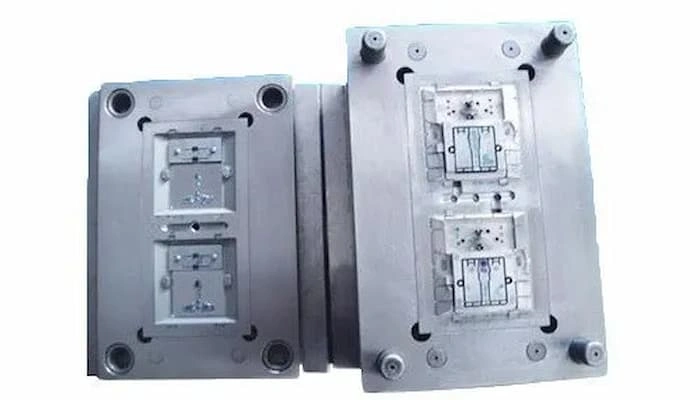
Mold for electrical switch
Plastic injection molding is also used for manufacturing durable, safe, and cost-effective electrical switches. For this, tough, wear-resistant, thermally stable, and dielectric plastics are the primary choices. E.g., Melamine formaldehyde, ABS, and phenol-formaldehyde resin(Bakelite).
5. Decorative Flower Pots
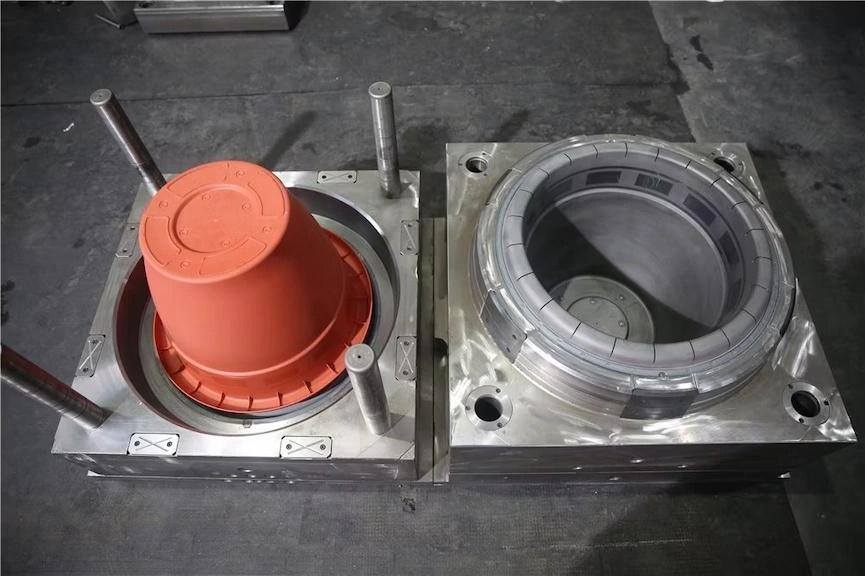
Injection molding of flower pot
Nowadays, clay or cement-casted flower pots are replaced with high-strength sustainable plastics, including Polypropylene, HDPE, and Polystyrene. You can customize pot shapes, sizes, textures, and colors using the molding technique.
6. Food and Beverage Containers
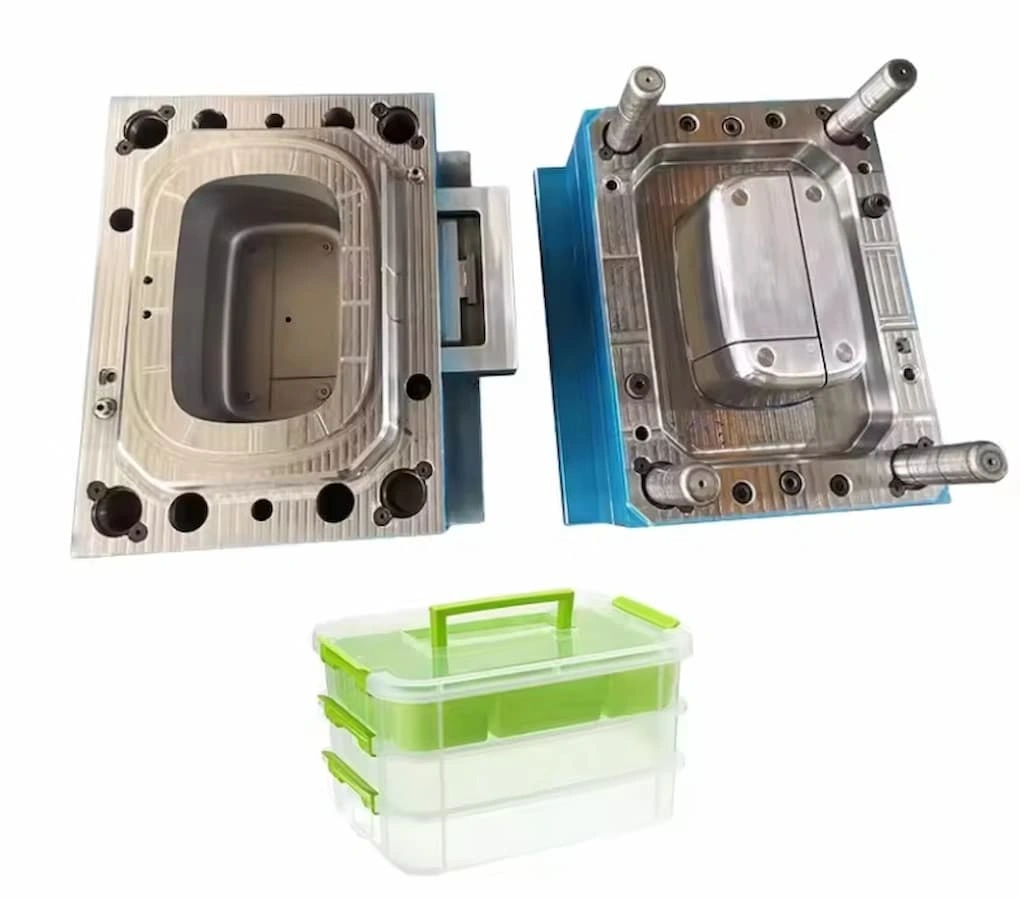
Food storage container and mold
With molding, you can make small-scale plastic boxes for storing kitchen essentials and large-sized industrial containers for food and beverages. Plastics with chemically inert, easy-to-clean, and stable properties are suitable for these containers. E.g., Polypropylene and Polyethylene terephthalate.
7. Medical Devices
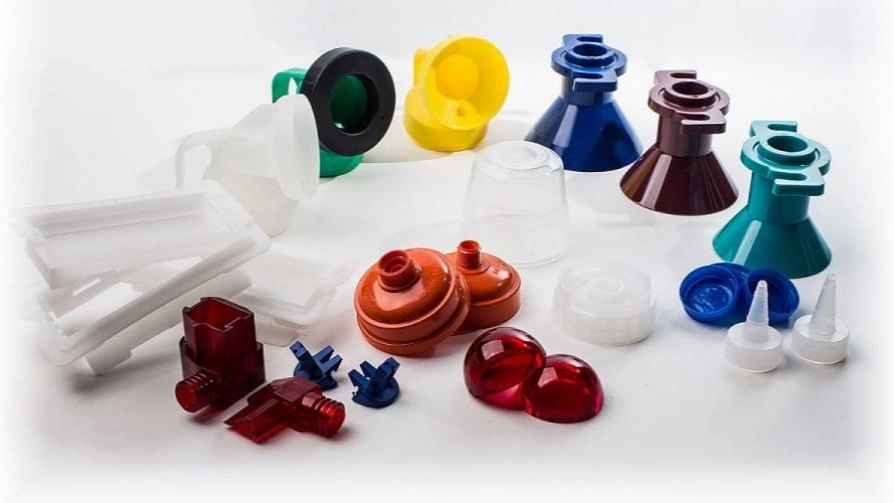
Molding items for medical devices
Another popular application area is medical injection molding, which includes various components for diagnostic devices, equipment enclosures, artificial limbs, inhalers, syringes, and surgical instruments.
It is important to ensure the use of medical-grade plastics to mold critical medical products. For example, FAD regulates this under the 21 CFR in the United States, whereas other regions or countries have similar provisions under their own regulatory bodies.
8. Automotive Panel and Air Vent
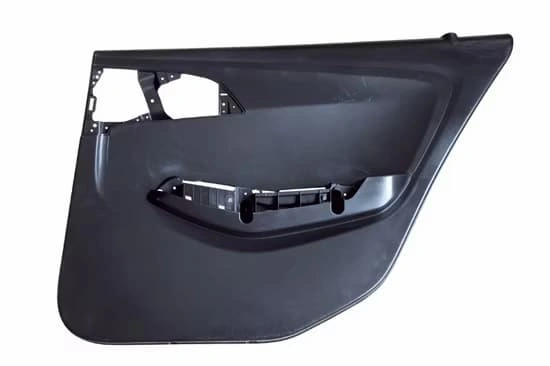
Automotive door panel
Injection molding provides design flexibility and superior finish in the production of automotive interiors like panels and air vents. For most of the vehicles, dashboards or panels are made with PC and ABS, whereas Polypropylene is a better option for the air vents. Consequently, it allows for complex features to meet new standards of automotive aesthetics.
9. Threads and Fittings
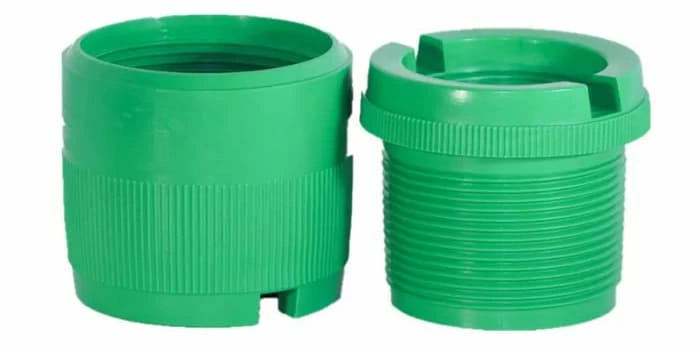
Plastic thread fittings
Threaded and fitting products made by plastic molding include snap-fit features, threads on the bottleneck, internal threads on the bottle cap, thread inserts, press-fitting elements, etc. Although internal threads are simple to achieve, external threads might need a mold containing halved thread sections on both the core and cavity.
10. Insulators
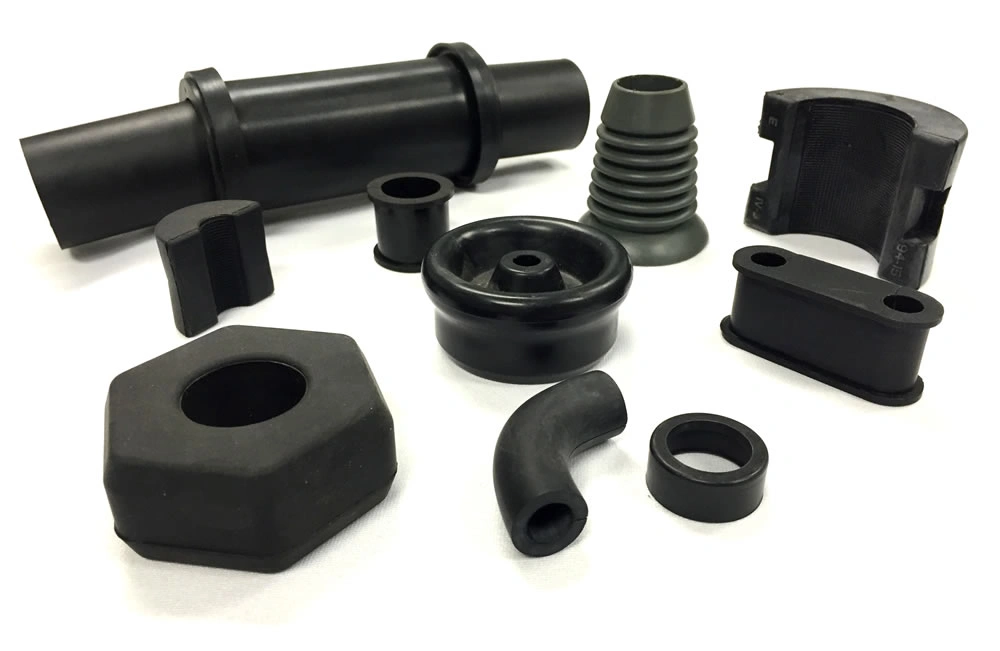
Injection molded insulators
Insulators prevent the unwanted current flow between conductive parts, and they are used in electrical and electronics systems. Molding is a viable option to make them, both technically and economically. For example, insulators are used in power outlets, short-circuit-prone areas, electrical pathways, and board spacers. Moreover, ABS and polycarbonate are the two main plastics used to mold insulators.
Try Prolean Now!
How Can You Customize Plastic Products with Molding?
It is the process of creating molded plastic parts that are tailored to serve specific functionality and aesthetic requirements. Customization gives room for innovations or updating the existing market products with additional features. Moreover, the manufacturer also needs special molds and adjustments to standard procedures to meet custom requirements.
- Identify the customization variables like geometrical features, dimensions or sizing, needed performance, and material selection.
- Create a 3D design of parts and mold to produce those parts.
- Optimize the design, make custom mold, and adjust other necessary tooling elements.
- Trial run the mold to see customization results before developing the hard tooling.
- Optimize again based on findings and start the production process.
What Are the Advantages of Products that are Injection Molded?
The key advantages are production speed, cost with high volumes, customization, and dimensional accuracies.
Highly Repeatable Process:
A single mold can make hundreds of thousands of identical plastic parts, emphasizing repeatability and quality consistency.
Structural Integrity:
Even complex products can be molded to minimize the assembly steps, which helps maintain high structural integrity. However, optimizing mold design is essential for this.
Tight Tolerances and Finish:
Typically, it is easy to maintain a tolerance of ±0.1 mm with injection molded plastic products, whereas it can be as low as ±0.025 for precision applications like medical devices and aircraft components. Next, you can also make a textured or smooth finish, depending on the necessities for the functionality.
Cost Efficiency in High-Volume Runs:
Once the initial tooling( injection mold and other setup arrangement) is completed, the per-unit cost decreases significantly for every extra production cycle. So, injection molded parts are the cost-effective choice.
Fast Production :
An injection molding cycle time ranges from 10 seconds to a few minutes at maximum, less than 4 minutes in most cases. This speed is not only beneficial for the reduction of production time and cost but also provides a competitive edge in the market.
Common Injection Molding Defects And Solutions
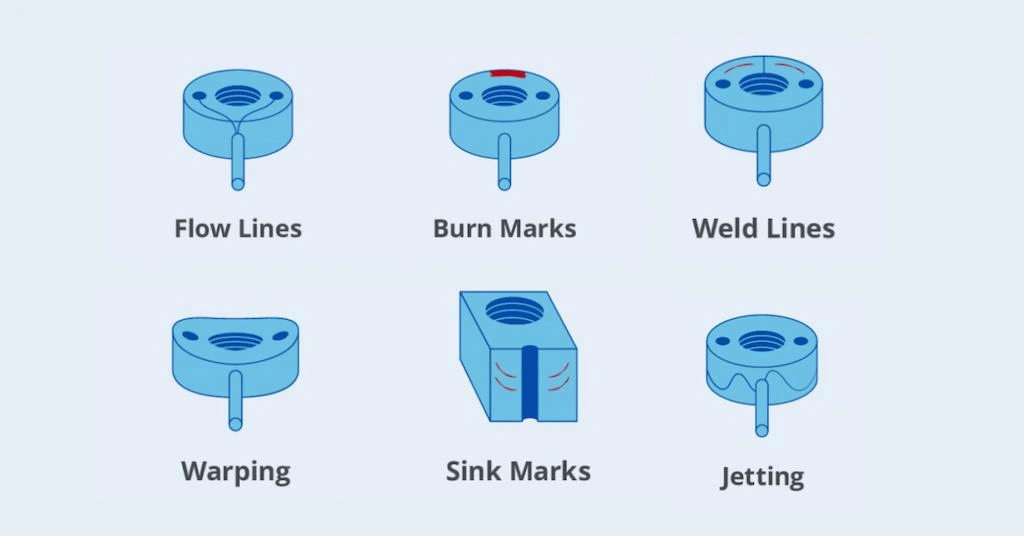
Injection molding defect list
There are some risks of visible defects and performance inefficiency in molded plastic parts that cause failure during applications or increase the % of defective items.
The injection molding defects are mainly associated with;
- Properties and quality of raw plastic material
- Mold design and its manufacturing
- Surface finish of cavity walls
- Injection molding variables and procedures
- Calibration of molding equipment and auxiliary systems
Now, let’s look at the common defects and how you can address those issues;
Defect 1: Flash (Excess Material on the Mold’s Parting Line)
Solutions: Control the injection pressure, align the mold halves accurately, and provide a better clamping force to secure mold halves.
Defect 2: Sink Marks on Surface
Solutions: Incense the pressure of injecting flow to avoid shrinkage, adjust gate location based on flow pattern, and enhance your control over cooling rate.
Defect 3: Short Short ( Incomplete filling of Cavity)
Solution: Improve injection speed and raise liquid temperature for better flowability.
Defect 4: Material Wrapping( Twisting due to inconsistent shrinkage)
Solution: Optimize mold design for uniform thickness, consider the shrinkage tendency of raw material, and adjust the flow temperature inside the cavity.
Defect 5: Delamination ( Separation or layer Peeling off)
Solution: Ensure material compatibility and zero contamination in feed.
Defect 6: Jetting ( Wavy or snake-like patterns on the surface)
Solution: Control (reduce) injection speed, increase mold temperature, minimize the flow turbulence, and optimize the gate size.
The risk of defects can be different from one method to another. For example, insert molding parts are more prone to defects on internal surfaces.
“For more technical details on types, read the article: six injection molding types.”
Outsourcing Injection Molding Services from China
As said previously, injection molding is a complex manufacturing process that requires extensive machinery and human expertise to produce plastic products meeting all specified requirements. So, outsourcing them can be a better choice for businesses instead of investing heavily in factory setup. For small volumes and prototypes, you can use rapid injection molding by adapting soft tooling strategies.
Often, many global-scale businesses are turning to China injection molding suppliers due to a large network of material supply chains and advanced molding capabilities; ProleanTech is one such example that has been providing plastic injection molding service for more than a decade.
How to Outsource from China?
For injection molding outsourcing, first ensure whether you only want injection mold & tooling fixtures or final plastic products(ready to use or sell). For tooling, asses the mold manufacturing capabilities like CNC, laser cut, EDM, etc. But, if you want complete solutions, go with a few extra steps to examine the available suppliers and their offerings.
- Search available companies on the internet; prefer those that have in-house manufacturing factories/shops.
- Identify your requirements, like part size, production volume, tolerance levels, and project timeline. Then, shortlist the companies that have the potential to fulfill those requirements.
- Ask for the quotes and other additional information from short-listed companies and compare the price with the quality they can offer.
Need quotations for your designs? Upload your file with the desired specifications in our online injection molding portal. Our engineers will get back to you within a few hours.
Try Prolean Now!
Wrapping Up
Diverse parts and products are possible to create with plastic molding technology, ABS, PC, Nylon, PP, PE, LDPE, and many other materials. The product range expands from everyday consumer items to automotive and medical components. But, the molded items are also prone to defects like sink marks, wrapping, short shots, delamination, etc. You can avoid these by optimizing mold design, using the right processing parameters, and accurately calibration of involved equipment.
FAQs
How to design plastic injection molded parts?
The designs for plastic parts are generally created in computer design softwares. However, it is essential to consider factors like uniform wall thickness, draft angles, and shrinkage.
How to make threaded parts using plastic injection molding?
A common practice for molding threaded parts is the use of a mold with threads and an unscrewing mechanism to release solidified parts. However, for internal threads, collapsible cores are preferable.
How to prevent plastic leaking from parting line injection molding?
Leakage from parting lines is a common quality issue, which is typically associated with the misalignment of parting lines. For prevention, align mold halves accurately and ensure proper clamping force.
How to remove threaded parts from a plastic injection mold?
There are three main ways to remove threaded parts from the injection mold: unscrewing mechanism, collapsible core, and stripping. It depends on whether threads are on internal or external surfaces.
What are typical tolerances for plastic injected molded parts?
Although exact tolerance depends on the design complexity and capability of the injection molding machine. However, the typical tolerances are as follows;
- Linear: ±0.1 to ±0.2 mm, ±0.0025 mm for precise parts
- Hole ⌀= ±0.1 ±0.05 mm
- Angular: ±1 to ±0.5° mm

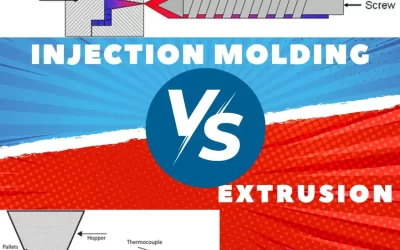
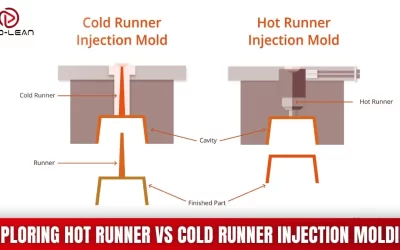
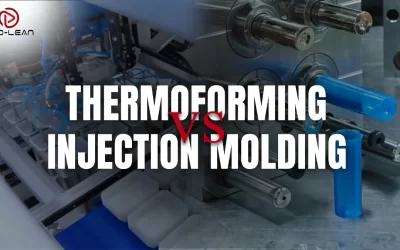
0 Comments